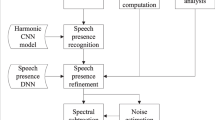Abstract
As a new high-tech industry, the application of speech recognition technology is becoming more and more competitive, with a wide range of application fields and application prospects, and has far-reaching significance for the development of science and technology. The communication environment of wireless communication network will bring various types of noise to speech, so an anti noise speech recognition method based on deep learning of wireless communication network is designed to achieve anti noise speech recognition in this environment. The voice signal of wireless communication network is preprocessed by anti aliasing filtering, analog-to-digital conversion, pre emphasis, framing and windowing, endpoint detection, etc. A series of denoising processes are implemented for the voice signal of wireless communication network, and different speech preprocessing methods are adopted for different characteristics of noise. A speech signal feature extraction method based on improved EMD is designed and implemented. The speech recognition model is designed based on the regression neural network in deep learning, and the anti noise speech recognition of wireless communication network is realized. Test results show that the lowest word error rate of this method is 0.156, and the word error rate is also low.
Access this chapter
Tax calculation will be finalised at checkout
Purchases are for personal use only
Similar content being viewed by others
References
Michelsanti, D., Tan, Z.H., Zhang, S.X., et al.: An overview of deep-learning-based audio-visual speech enhancement and separation. IEEE/ACM Trans. Audio Speech Lang. Process. PP(99), 1 (2021)
Goehring, T., Archer-Boyd, A.W., Arenberg, J.G., et al.: The effect of increased channel interaction on speech perception with cochlear implants. Sci. Rep. 11(1), 1–9 (2021)
Datta, H., Hestvik, A., Vidal, N., et al.: Automaticity of speech processing in early bilingual adults and children– CORRIGENDUM. Bilingualism: Language and Cognition 24(2), 1 (2021)
Kapnoula, E.C., Mcmurray, B.: Individual differences in speech perception: evidence for gradiency in the face of category-driven perceptual warping. J. Acoustical Soc. Am. 149(4), A54–A54 (2021)
Kyaw, W.T., Sagisaka, Y.: Studies on association characteristics between vowels and visual colors using multiple speakers’ speech. Acoust. Sci. Technol.. Sci. Technol. 42(4), 161–169 (2021)
Abryutina, A., Ponomareva, A.: German-English Interference in the Field of Vocalism (Based on the Speech of Germans who Study English as a Foreign Language). Izvestia of Smolensk State University 1(53), 128–143 (2021)
Qiang, H.: Consumption reduction solution of TV news broadcast system based on wireless communication network. Complexity 2021(23), 1–13 (2021)
Dong, N., Lv, W., Zhu, S., et al.: Anti-noise model-free adaptive control and its application in the circulating fluidized bed boiler. Proc. Inst. Mech. Eng. Part I J. Syst. Control Eng. 235(8), 1472–1481 (2021)
Wang, Q., Jiang, X., Weng, B., et al.: A 3D curvature attribute analysis method with excellent anti-noise property suitable for high steep formation. Geophys. Prospect. Petroleum 56(4), 559–566 (2022)
Guan, Y., Hu, Z., Chen, C., et al.: An anti-noise transmission algorithm for 5G mobile data based on constellation selection and channel joint mapping. Alex. Eng. J. 60(3), 3153–3160 (2021)
Basak, S., Agrawal, H., Jena, S., et al.: Challenges and limitations in speech recognition technology: a critical review of speech signal processing algorithms, tools and systems. Comput. Model. Eng. Sci. 2023(5), 1053–1089 (2023)
Hadwan, M., Alsayadi, H.A., AL-Hagree, S.: An end-to-end transformer-based automatic speech recognition for qur’an reciters. Comput. Mater. Continua 2023(2), 3471–3487 (2023)
El-Bialy, R., Chen, D., Fenghour, S., et al.: Developing phoneme-based lip-reading sentences system for silent speech recognition. CAAI Trans. Intell. Technol. 8(1), 129–138 (2023)
Kamal, M.B., Khan, A.A., Khan, F.A., et al.: An innovative approach utilizing binary-view transformer for speech recognition task. Comput. Mater. Continua 2022(9), 5547–5562 (2022)
Alsulami, N.H., Jamal, A.T., Elrefaei, L.A.: Deep learning-based approach for Arabic visual speech recognition. Comput. Mater. Continua 2022(4), 85–108 (2022)
Nisar, S., Khan, M.A., Algarni, F., Wakeel, A., Irfan Uddin, M., Ullah, I.: Speech recognition-based automated visual acuity testing with adaptive mel filter bank. Comput. Mater. Continua 2022(2), 2991–3004 (2022)
Author information
Authors and Affiliations
Corresponding author
Editor information
Editors and Affiliations
Rights and permissions
Copyright information
© 2024 ICST Institute for Computer Sciences, Social Informatics and Telecommunications Engineering
About this paper
Cite this paper
Zhang, Y., Ma, L., Du, H., Li, J. (2024). Anti Noise Speech Recognition Based on Deep Learning in Wireless Communication Networks. In: Yun, L., Han, J., Han, Y. (eds) Advanced Hybrid Information Processing. ADHIP 2023. Lecture Notes of the Institute for Computer Sciences, Social Informatics and Telecommunications Engineering, vol 547. Springer, Cham. https://doi.org/10.1007/978-3-031-50543-0_11
Download citation
DOI: https://doi.org/10.1007/978-3-031-50543-0_11
Published:
Publisher Name: Springer, Cham
Print ISBN: 978-3-031-50542-3
Online ISBN: 978-3-031-50543-0
eBook Packages: Computer ScienceComputer Science (R0)




